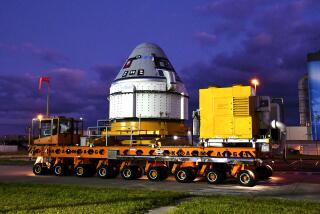First Post-Challenger Shuttle Launch Set for February, 1988 : Military Missions Win Priority in ‘Prudent’ Manifest
- Share via
CAPE CANAVERAL, Fla. — The first post-Challenger shuttle mission is scheduled for launch Feb. 18, 1988, with military missions accounting for more than 40% of all flights through the end of 1994, NASA announced today.
“This shuttle manifest is based on a flight rate goal that we believe is acceptable and prudent,” NASA Administrator James Fletcher said.
“It complies with White House policy that NASA will no longer launch commercial and foreign payloads except those that are shuttle-unique or those that have national security or foreign policy implications.”
The prominence of the military flights was expected as the space agency works to eliminate a backlog of high-priority Defense Department payloads grounded by the Challenger disaster.
Classified Missions
In all, five missions are planned for 1988:
--Feb. 18: Discovery; payload: second tracking and data relay satellite.
--May 26: Atlantis; payload: classified military mission.
--July 28: Columbia; payload: classified military mission.
--Sept. 22: Discovery; payload: third tracking and data relay satellite.
--Nov. 17: Atlantis; payload: $1.3-billion Hubble Space Telescope.
The goal of resuming flights in February, 1988, is considered ambitious by some observers because of time needed to test redesigned shuttle solid-fuel rocket boosters. A booster failure led to Challenger’s destruction Jan. 28.
A key element in the schedule was whether the new boosters would be test-fired horizontally, the previous practice, or vertically, as recommended by the Challenger disaster commission, to more accurately simulate actual launch forces on fuel segment joints where Challenger’s rupture occurred.
Special Test Stand
Vertical test firings would require construction of an elaborate test stand for the 14-story rockets that officials said probably would add a year to the launch delay and more than $20 million in costs.
On Thursday, however, NASA said vertical test firings had been ruled out based on test data that showed horizontal firings will be sufficient to demonstrate the safety and reliability of the new rockets.
The manifest, one of NASA’s most closely guarded secrets, is sure to stir up debate in the science community and among commercial satellite owners who will not receive the launch priority they once expected.
Observers say lawsuits could be filed by companies whose satellites will have to be carried aloft by unmanned boosters as a result of President Reagan’s decision in August to ban most commercial satellites from the shuttle system.
Before the Challenger accident, 44 commercial satellites were booked for shuttle launch. NASA now expects to launch only about 19 of those before 1992, causing owners of the others to turn to expendable rockets.
More to Read
Sign up for Essential California
The most important California stories and recommendations in your inbox every morning.
You may occasionally receive promotional content from the Los Angeles Times.












